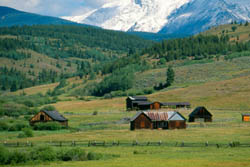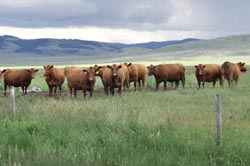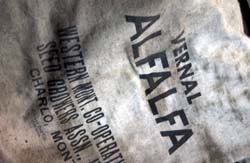Ranch Land
Updated: August 18, 2020

Montana is home to many cattle, sheep, and other animals. In fact there are more animals in the state of Montana than there are people. So, where do all these animals live, and what do they eat? We all know that their home does not consist of fancy "cow houses," but to a cow it is about the same thing! They live on Montana's vast area of rangeland. In fact, 70 percent of Montana consists of rangeland, which is made up of grassland, grazeable woodland, and watersheds. Animals use the variety of resources for food, shelter, and protection from predators. Fifty-eight percent of rangeland consists of grass, shrubs, and forbs.
Grass makes up the majority of rangeland, and is the main part of the animal's diets. It is important because it binds the soil to protect against erosion. Grass has narrow stems, leaves, and flowers.
Shrubs, bushes, and trees are identical to one another. They are made up of thick wood stems and broad leaves. Some shrubs and bushes even have colorful flowers. Animals will eat the shrubs, bushes, and trees in the winter when the grass is hard to reach.

Forbs are broad leaf plants with flowers. They die each winter only to return again in the spring to speckle the fields with their colorful flowers. Animals are just like humans--picky! If they do not like the taste of certain forbs, which occasionally they don't, they will refuse to eat them.
The majority of the rangeland is owned by ranchers who graze cattle, sheep, and other animals. The government also owns rangeland, which is generally leased by ranchers who care for the land, and manage the grass by raising livestock on it. Both the ranchers and the government are very careful to follow strict rules in order to protect the wild land so that the animals will always have a safe and healthy home.

Proper range management requires a combination of practices. The animals must be rotated from field to field so as not to overgraze the land, and watersheds and streams must be managed so they stay healthy. The rancher has to keep a watchful eye on the weeds so they do not dominate the land, which in turn reduces the food supply for the animals. If the weeds become too apparent, the rancher has to find new ways to manage them, and this can be a very difficult task. Proper range management is a full time job and requires the dedication of the rancher.
Rangeland is not just a home for domestic livestock, it also serves many other purposes. The land is also a home for wildlife, such as deer and antelope, and the watersheds provide a haven for ducks and geese. The wooded areas can be used for timber, and humans take advantage of the land for recreation, such as fishing, horseback riding, and hiking.
Thank you to the Department of Agriculture's Agriculture in Montana Schools program for providing much of this information.
Updated: August 18, 2020

